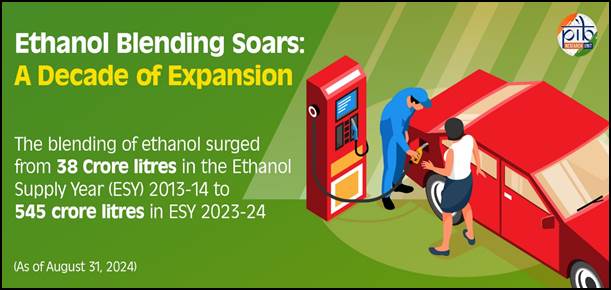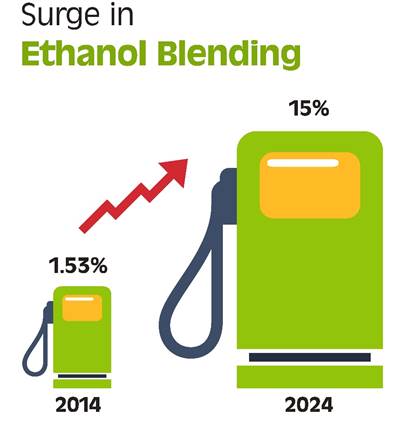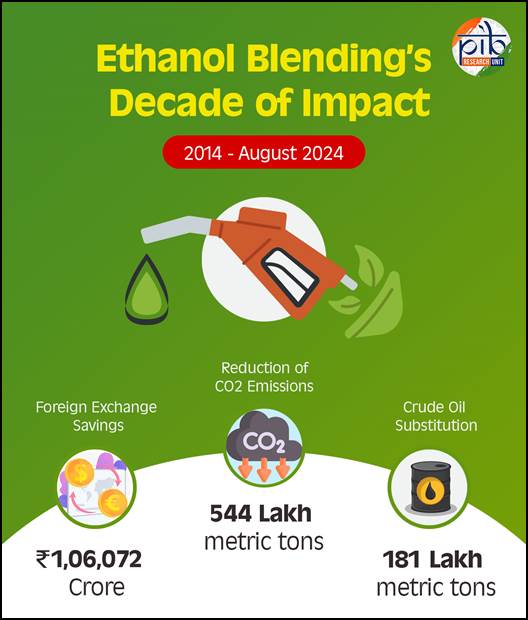Ministry of Petroleum & Natural Gas Champions Ethanol Blending: 15% by 2024, 20% by 2025
Introduction
India is taking significant steps toward securing its energy future by embracing sustainable practices like ethanol blending. As the world’s third-largest energy consumer, the country has traditionally depended on oil imports to meet its growing energy demands. This reliance not only poses challenges to energy security but also leads to a substantial outflow of foreign currency. However, with ethanol blending, India has a promising opportunity to reduce its dependence on imported oil while addressing environmental concerns. Ethanol, a byproduct of sugarcane processing, can be mixed with petrol, cutting down on fossil fuel consumption and reducing harmful carbon emissions that contribute to climate change and public health issues.
The practice of blending ethanol with petrol began in 2001 as a pilot project. Yet, for many years, progress was slow, and ethanol production remained stagnant. Only recently, through a series of comprehensive reforms, has India been able to unlock the full potential of this initiative. These reforms are now driving substantial outcomes, not just by enhancing energy security, but also by revitalizing rural economies. Ethanol production offers a new source of income for farmers, supporting the agricultural sector and fostering economic growth in rural areas.

Source: https://pib.gov.in/PressReleasePage.aspx?PRID=2055957
The government’s proactive approach to ethanol blending is evident in its decision to advance the target of 20% ethanol blending from 2030 to 2025, demonstrating a strong commitment to sustainable energy practices. During the 7th G-STIC Delhi Conference, Shri Hardeep Singh Puri, Minister of Petroleum and Natural Gas, emphasized India’s growing success in ethanol blending and its broader commitment to sustainable energy solutions. He highlighted that, in recognition of the progress made, the government has already begun planning for the future by exploring goals beyond the 20% ethanol blending target. This forward-looking approach indicates that India is not only focused on meeting its immediate energy needs but is also preparing for long-term sustainable energy solutions to address future demands.
Ethanol: A Versatile Biofuel
Ethanol is one of the primary biofuels, naturally produced through the fermentation of sugars by yeasts or through petrochemical processes like ethylene hydration. It is widely used not only as an alternative fuel source but also in various industries as a chemical solvent and in the synthesis of organic compounds. Ethanol also has medical applications as an antiseptic and disinfectant, adding to its versatile uses.
In the context of India’s rising energy demand, driven by factors such as a growing economy, an expanding population, increasing urbanization, and evolving lifestyles, ethanol plays a critical role. As of March 2024, around 98% of the fuel used in the road transportation sector comes from fossil fuels, while only 2% is met by biofuels like ethanol. This dependency on fossil fuels presents challenges related to energy security, foreign currency outflow, and environmental impact.
Ethanol, as a domestically produced biofuel, offers a strategic opportunity to reduce the country’s dependence on imported fossil fuels. When used responsibly, biofuels like ethanol are more environmentally friendly and sustainable, contributing to a cleaner energy landscape. Additionally, ethanol production and usage align with national goals like generating employment, promoting the “Make in India” initiative, supporting the Swachh Bharat Mission, and contributing to the doubling of farmers’ incomes. It also fosters the creation of wealth from waste, further enhancing its importance to India’s economy and energy security.
Major Achievements of EBP
Under the leadership of Prime Minister Narendra Modi, the government has embarked on a series of comprehensive reforms aimed at enhancing energy security, combating climate change, and boosting the rural economy. An indicative target of 20% ethanol blending in petrol was initially set for 2030 under the EBP Programme. However, in 2020, the Cabinet Committee on Economic Affairs (CCEA) advanced this target to 2025, reflecting the government’s commitment to accelerating ethanol usage.
The progress of India’s Ethanol Blended Petrol (EBP) Programme has been noteworthy, with the ethanol production capacity more than doubling in the last four years to reach 1,623 crore litres as of September 18, 2024. This substantial increase highlights the government’s commitment to enhancing the role of ethanol in the nation’s energy landscape.
In the Ethanol Supply Year (ESY), which runs from November to October, the blending of ethanol with petrol stood at 38 crore litres with a blending percentage of 1.53% in ESY 2013-14. Over the following years, the government implemented various initiatives that led to remarkable growth in ethanol blending. By ESY 2020-21, the blending volume surged to 302.3 crore litres, increasing the blending percentage to 8.17%. During this same period, petrol consumption also rose by approximately 64%

Source: https://pib.gov.in/PressReleaseIframePage.aspx?PRID=2050907
The momentum continued, with blending further increasing to over 500 crore litres in ESY 2022-23, raising the blending percentage to 12.06%. In the current ESY 2023-24, the blending percentage surpassed 13% with approximately 545.05 crore litres of ethanol blended as of August 31, 2024. This remarkable progress underscores a significant increase in the overall ethanol blending percentage, rising from 1.53% in 2014 to an impressive 15% in 2024.
Encouraged by this progress, the government set an ambitious target of achieving 20% blending by 2025. Over the past decade, this initiative has delivered significant benefits, including savings of ₹1,06,072 crore in foreign exchange, a reduction of CO2 emissions by 544 lakh metric tons, and a substitution of 181 lakh metric tons of crude oil. Furthermore, the program has had a considerable economic impact, with OMCs disbursing ₹1,45,930 crore to distillers and ₹87,558 crore to farmers.

Source: https://x.com/PetroleumMin/status/1846195338715320506
Key Measures to Achieve 20% Ethanol Blending by 2025-26
To achieve the target of 20% ethanol blending by 2025, approximately 1,016 crore litres of ethanol will be required. The total demand for ethanol, including other uses, is estimated to be around 1,350 crore litres. To meet this requirement, an ethanol production capacity of about 1,700 crore litres must be established by 2025, assuming the plants operate at 80% efficiency. The government has projected the demand for ethanol necessary for 20% blending by considering the growth of petrol-based vehicles, particularly in the two-wheeler and passenger vehicle segments, as well as the anticipated sales of Motor Spirit (MS).
Here are the key initiatives:
- In August 2024, The Union Cabinet, chaired by Prime Minister Shri Narendra Modi, approved the modified Pradhan Mantri JI-VAN Yojana to keep pace with the latest developments in biofuels and attract more investment. This modified scheme extends the timeline for implementation by five years, until 2028-29, and expands its scope to include advanced biofuels produced from lignocellulosic feedstocks, such as agricultural and forestry residues, industrial waste, synthesis (syn) gas, and algae.
- The government has developed a detailed roadmap for ethanol blending to guide effective implementation.
- Efforts are underway to expand the feedstock used for ethanol production, allowing for more efficient and sustainable sourcing.
- A favourable procurement price for ethanol has been established under the EBP Programme, ensuring fair compensation for producers.
- The Goods and Services Tax (GST) on ethanol for the EBP Programme has been reduced to 5%, making it more financially attractive for producers and consumers.
- Changes have been made to the industries (Development & Regulation) Act to facilitate the free movement of ethanol across states, promoting easier blending operations.
- An interest subvention scheme has been introduced to provide interest subsidies aimed at enhancing and augmenting ethanol production capacity in the country.
- Public Sector Oil Marketing Companies (OMCs) are actively floating Expressions of Interest for the procurement of ethanol, ensuring a steady demand and fostering market growth.
Conclusion
In conclusion, India’s commitment to ethanol blending represents a transformative approach to energy security, environmental sustainability, and economic development. With a significant increase in ethanol production capacity and blending percentages, the government is making substantial strides towards its ambitious target of 20% blending by 2025. The strategic measures implemented, such as the modified Pradhan Mantri JI-VAN Yojana and a detailed roadmap for ethanol blending, are pivotal in overcoming past challenges and unlocking the full potential of this initiative. As India continues to advance in this domain, the dual benefits of reducing reliance on imported fossil fuels and revitalizing rural economies will not only contribute to a cleaner energy future but also foster economic resilience. The ongoing efforts underscore a proactive approach to sustainable energy solutions, positioning India as a leader in biofuel adoption and setting a precedent for others to follow.

